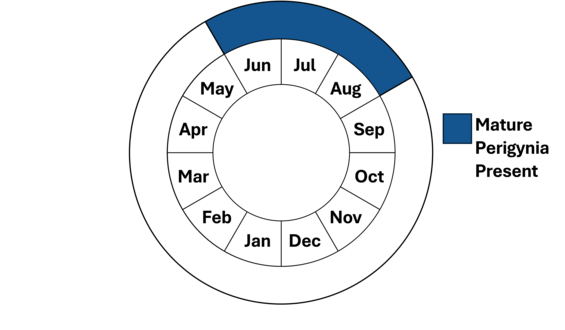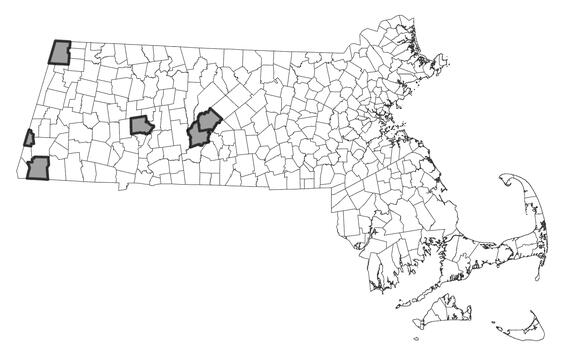- Scientific name: Carex bushii
- Species of Greatest Conservation Need (MA State Wildlife Action Plan)
- Endangered (MA Endangered Species Act)
Description
Bush’s sedge, a member of the sedge family (Cyperaceae), is a perennial, herbaceous, grass-like plant of moist woods, wet meadows, dry fields and prairies. It grows in loose clumps of slender, sharply angled stems from 30-90 cm (1-3 ft) tall with reddish-purple bases. It was named in honor of botanist Benjamin Franklin Bush (1858-1937).
To identify Bush’s sedge and other members of the genus Carex, a technical manual should be consulted. Species in this genus have tiny, wind-pollinated flowers that are borne in spikes. Each flower is unisexual, and is closely subtended by small scales that largely conceal the flowers. The staminate (i.e., pollen-bearing) flowers are subtended by a single scale. The pistillate (i.e., ovule-bearing) flowers are subtended by two scales, an outer flat scale (pistillate scale) and an inner, sac-like scale, called a “perigynium,” that encloses the flower, and later, the achene (a small, hard seed-like fruit). If the perigynium tapers or contracts to a tip, it is described as a “beak.”
Bush’s sedge belongs to a group of Carex (section Porocystis), that have pubescent (hairy) leaves and trigonous achenes. Bush’s sedge, specifically, has a terminal spike that bears both staminate flowers (usually evident as empty-looking scales at the base of the spike) and pistillate flowers, with the erect lateral spikes usually crowded beneath. The spreading perigynia are pubescent and also covered with minuscule bumps (“papillae”). They are beakless, strongly 9-13 veined, and round in cross-section. The pistillate scales are reddish-brown, longer than the perigynia, and distinctly awned. The achene inside each perigynium bears a deciduous, protruding style that is bent at its base.
Bush’s sedge co-occurs with, and is very similar in growth habit to, the hirsute sedge (Carex hirsutella). However, the perigynia of the hirsute sedge are flattened, not round, in cross section. The perigynia of the hirsute sedge are more strongly ascending in the spike than those of Bush’s sedge, which spread at a greater angle from the inflorescence axis. Finally, the awns of the pistillate scales in the hirsute sedge are usually shorter (0.5 mm; 0.02 in), occasionally as long as 1 mm; 0.04 in) and less conspicuous than those in Bush’s sedge (0.5-2 mm; 0.05-0.08 in).

Population status
Bush’s sedge is listed under the Massachusetts Endangered Species Act as Endangered. All listed species are protected from killing, collecting, possessing, or sale and from activities that would destroy habitat and thus directly or indirectly cause mortality or disrupt critical behaviors. There are six current stations (sites where verified as extant since 1984) and one historical station (unverified since 1984) in the Commonwealth. The current stations are from four towns in Berkshire County and two towns in Hampshire County. The historical station is from one town in Middlesex County. Bush’s sedge is rare because it is nearing the northeastern limit of its range in Massachusetts, and because it is primarily found in areas overlying calcareous bedrock. The MassWildlife’s Natural Heritage & Endangered Species Program database has 7 records from 4 counties: Berkshire, Hampshire, and Worcester. Five of these records have been observed within the last 25 years.
Distribution and abundance
The documented range of Bush’s sedge extends from Maine to Nebraska on the north to the Gulf Coast on the south.

Distribution in Massachusetts
1999-2024
Based on records in the Natural Heritage Database
Habitat
Bush’s sedge occurs in dry to mesic calcareous meadows and pastures in Massachusetts. Associated species include field sedge (Carex conoidea), hirsute sedge (C. hirsutella), pendulous bulrush (Scirpus pendulus), and shrubby cinquefoil (Pentaphylloides floribunda). In dry pastures, it has been observed among many non-native weed species, such as black-eyed susan (Rudbeckia hirta), multiflora rose (Rosa multiflora), barberry (Berberis spp.), and buckthorn (Rhamnus spp.).
Healthy habitats are vital for supporting native wildlife and plants. Explore habitats and learn about conservation and restoration in Massachusetts.
Threats
The succession of fields and pastures to forest likely threatens this species.
Conservation
As for many rare species, exact needs for management of Bush’s sedge are not known. Little is known about the specific requirements of Bush’s sedge, but observations of existing populations suggest it may be tolerant of moderate disturbance, such as grazing or annual mowing. Nevertheless, drastic alterations of the pasture or meadow habitats that support Bush’s sedge may have negative impacts on a population. Some actions to better manage populations of Bush’s sedge might include timed mowing, cutting back trees and shrubs, and removing invasive non-native plants such as barberry, multiflora rose, and buckthorn.
Contact
| Date published: | April 9, 2025 |
|---|